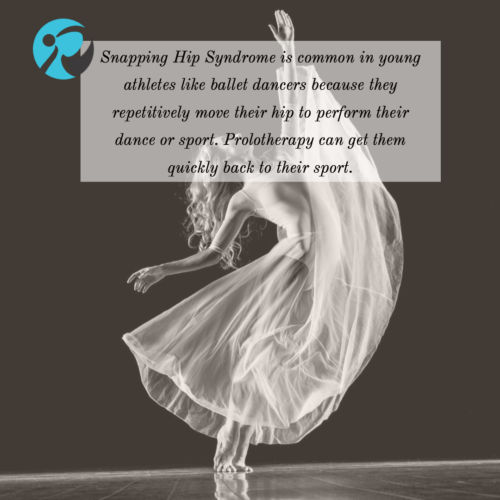In Snapping Hip Syndrome, sufferers hear or feel a snap, pop, or click when they move their hip joint. Encountering these symptoms is not a normal process, but one that points to an injury or degenerative condition.
There are several reasons Snapping Hip Syndrome occurs, and they can be due to problems either inside or outside of the hip joint.
Most commonly, the condition involves a thick, wide tendon called the iliotibial band that runs along the outside or lateral side of the hip joint. The iliotibial band snaps over the bony prominence, a part of the thigh bone that sticks out, called the greater trochanter on the outside of the hip.
When a person with this condition moves into a standing position for example, the band may be positioned behind the trochanter. And then when bending the hip, the band will move and “snap” over towards the front of the bony prominence. Over time, irritation from this “snapping” may also result in bursitis.
Another tendon is involved in the second cause of Snapping Hip Syndrome, as it catches on underlying bony prominences of the pelvis. The iliopsoas tendon snaps over the iliopectineal eminence when bending or flexing the hip. The annoying snapping sensation or sound is generally the only symptom involved when the iliopsoas tendon is the source.
An additional area where snapping can occur is located where the ball of the hip joint fits into the socket. This snapping involves the rectus femoris tendon as it runs from inside the thighbone and up through the pelvis. When the hip joint bends and straightens, the tendon moves and snaps back and forth across the ball of the hip joint.
The least common cause of Snapping Hip Syndrome occurs inside the hip joint and involves a tear in the hip labrum or a tear in the cartilage. Bits of cartilage or even bone can also become loose inside the joint, in these types of injuries. These pieces are called loose fragments and can be an associated cause of Snapping Hip Syndrome which can cause the hip to lock up. In this scenario inside the hip, the sufferer often experiences pain that is disabling.
A combination of the various causes, plus muscle injury can also occur. Additionally, if the problem is ongoing and the tendons remain lax over a prolonged period of time, Snapping Hip Syndrome can lead to arthritis.

Snapping Hip Syndrome in Athletes
Snapping Hip Syndrome is common in young athletes like ballet dancers, soccer players, and runners. Dancers and other athletes repetitively move their hip in order to perform their dance or sport.
If the hip and the tendons are moving abnormally, such as with Snapping Hip Syndrome, the abnormal rubbing and snapping of the tissue over bony prominences will occur again and again.
When experiencing the symptoms, these athletes will frequently turn to treatments to relieve tight muscles, because they attribute their problem to overtraining. Treating muscles may give some relief, but will not repair the underlying injury to the ligaments, tendons, and/or hip labrum.
Treatments that repair these soft tissue structures are necessary to stabilize the hip joint and stop the snapping from occurring.
Regenerative Orthopedics directed towards the strengthening of these tendons and any involved ligaments, plus repair of the hip labrum, can tighten the joint and resolve the problem.
Oftentimes an underlying problem of looseness or laxity of the hip joint is involved, causing instability of the hip joint. Regenerative Orthopedics treats the hip instability, because it tightens and strengthens the injured and lax structures, and regenerates the areas that need healing. The treatment actually gets to the root cause of the problem, and is effective at repairing the injured soft tissue, and resolving the problem.
The injected solutions in Regenerative Orthopedic treatments draw immune cells and growth factors to the area in an effort to build new healthy soft tissue. The healing and repair boosts the body’s natural response of healing in soft-tissue injuries. The result is ligaments and tendons that are stronger, and no longer loose. The snapping and pain goes away, and the athlete can return to the sport they love.
If the cause of Snapping Hip Syndrome is a torn labrum or cartilage, a more advanced technique of Regenerative Orthopedics, including Stem Cell Therapy and/or PRP, may be required. Labral tears respond well to these treatments. And cartilage, if involved, can regenerate too. If loose fragments are an issue, the physician will need to determine whether or not surgical removal is necessary.
Regenerative Orthopedic treatments for Snapping Hip Syndrome get to the root cause of the condition. Specifically, the damaged connective tissues like tendons ligaments, and labrum, can be repaired and healed. That means you return quickly to the sports and activities you enjoy doing.